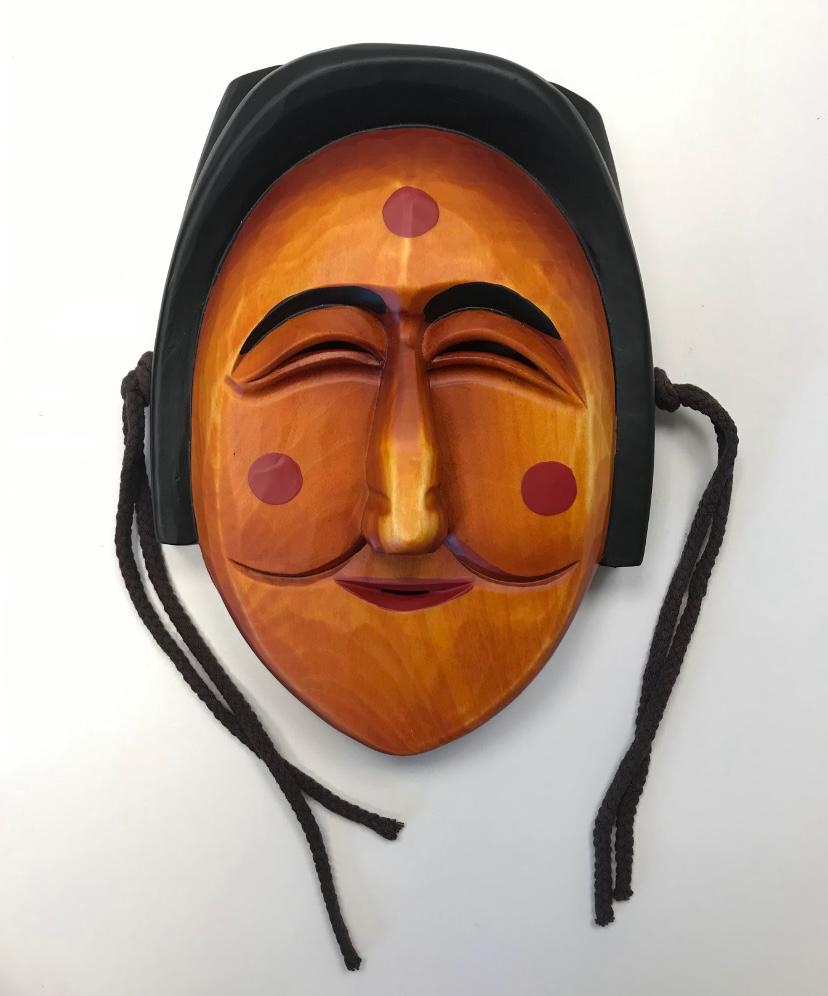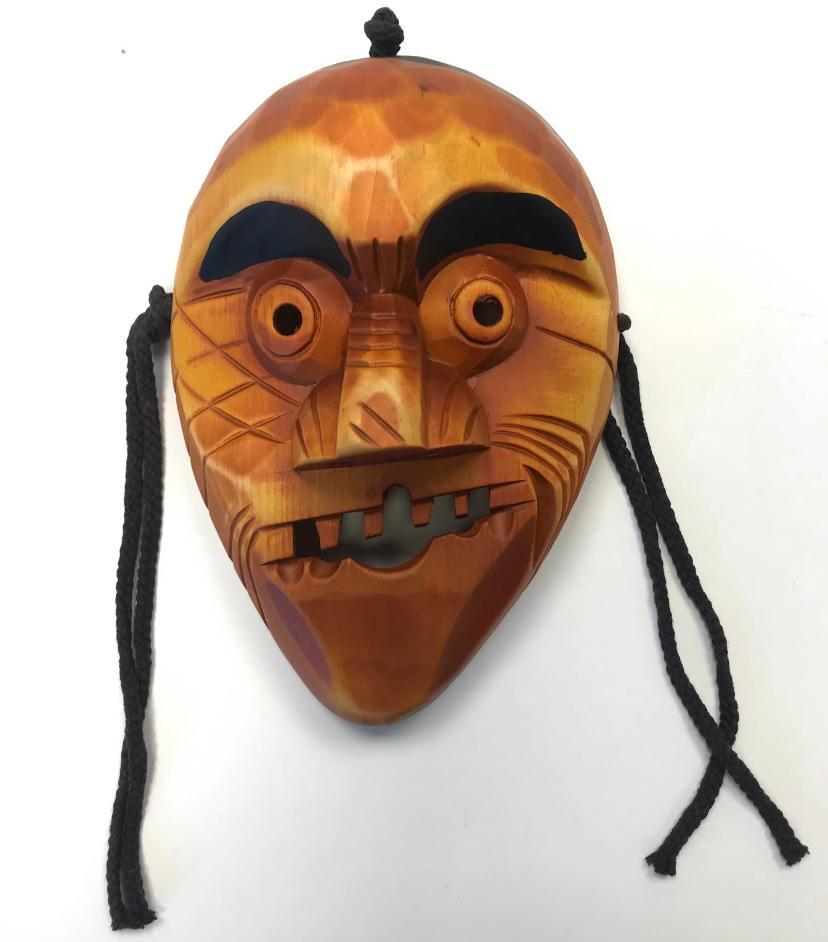There are many kinds of traditional mask dance in Korea. Among them is Hahoe Mask Dance, which was designated as Important Intangible Cultural Heritage No. 69 by the Korean government in 1980. On one hand, the mask dance reveals the hard life of the commoners; and on the other, it satirises the complacency and hypocrisy of the ruling class, such as the aristocrats and Buddhist monks, exposing social contradictions at that time in ironic, witty ways. In the name of pleasing the gods, the commoners can express their dissatisfaction, while the ruling class can understand the feelings of the commoners. There are different characters in each performance.

The Bride (Kaksi)
The mask is painted in a way that the character has long black hair covering her ears down to her chin. She has six braids of hair, a broad forehead, a long yet flat nose and prominent cheekbones. Squinting eyes, tightly closed lips and slightly lowered head indicate her shy and quiet disposition. She is the child god who guards Hahoe Village, and the god of Ujin Seong Cheong Hwang.

The Concubine (Bune)
Used by the scholar’s concubine. The oval face has a broad chin, crescent-like eyes and a faint smile. The horned hair is styled differently from the Bride.

The Butcher (Baekjeong)
Used by butchers who slaughter cattle. The mask has a long, large face with a broad jaw and deep wrinkles, showing immense power. The small round nose has wide nostrils with a short and raised nose bridge. His fierce aura can be felt in the eyes. The large spot on his forehead, rough skin, squinting eyes and somewhat cunning smile hint at a brutal character.

The Nobleman (Yangban)
There are fine wrinkles on the cheeks and the eyes, showing a squinting and smiling expression. Under the nose and the lips, there is a place to hang a beard, and the hooked nose gives a gentle yet strong impression. One of the common styling features of Hahoe masks is that the nose is centred, the right face narrower, and the cheekbones lower. Here however, the right cheekbone of the nobleman is more prominent and the left chin slanted, thus breaking the balance.

The Buddhist Monk (Chung)
Wrinkles are carved around the ends of his eyes, and his eyes narrowed with a sly smile. There is a small bump on the forehead in between the eyebrows. A hooked nose, and the chin is hung by a rope alone. There is a hole under the nose near the chin where the beard is inserted. On his forehead is a white tiger symbolising the Buddha, with a fist-like nose, and his double eyelids squinted with a sly smile. The structure of the chin is different from the nobleman, the scholar and the butcher.

The Fool (Imae)
The scholar's servant, also known as the Fool's Mask. Squinting, eyebrows drooping down, the wrinkles on the forehead and cheeks combined. Face slanted, showing a smirk expression with no nose and chin. Although the right eye is small, the left eye is wide but thin as if the character is grinning. The corners of the eyes droop very far and thus showing an innocent expression.

The Granny (Halmi)
The mask has round eyes with deep-set brows, a towering little nose, wrinkles carved on the cheeks, corners of the eyes and the mouth, and a fixed pointed chin. With the mouth wide open, the wearer’s lips and teeth are thus displayed intact, complementing the eye movements behind the small holes while animating all the facial expressions. As if spooked, the round eyes are filled with energy, the eyebrows deeply sunken, and the left eyebrow twisted. The pointed nose has no flesh, and this is the only one among the nine Hahoe masks that has no nostrils.

The Scholar (Sonbi)
Wrinkles are carved on the edges of the forehead, eyes, and cheeks. Round eyes, a slightly arrogant expression, and the chin hangs alone for ease of movement. Under the nose and the lower lip is a place to hang a beard, and a hole for hanging a control rope at the lower left of the chin. A large hooked nose is also one of the characteristics. The scholar's mask is a typical expression for someone who has reached extreme anger. For overall balance, the chin is not sculpted separately, but is sculpted with the face from the start and then parted.

The Nobleman’s Servant (Choraengi)
Used by the nobleman’s servant with an arrogant personality. The small round eyes protrude and have an opening, as with the mouth. The mouth slightly open. Although the chin is fixed, the wearer uses the half-opened mouth and the small round eyes to show expressions. There are slight wrinkles on the cheeks. With an overly pointed chin, an inverted triangular face protrudes from the forehead, as if startled, and the round eyes very deep. The wrinkled nose bridge, the exposed crooked teeth, and the low cheekbones of Choraengi are similar to those of monkeys. Small face, silly and agile movements are also typical of monkeys. Of particular note are the horizontal wrinkles on the nose bridge, which can be seen on monkeys but not humans.

